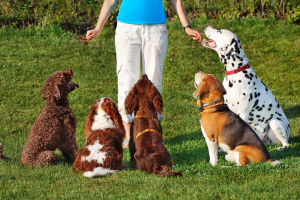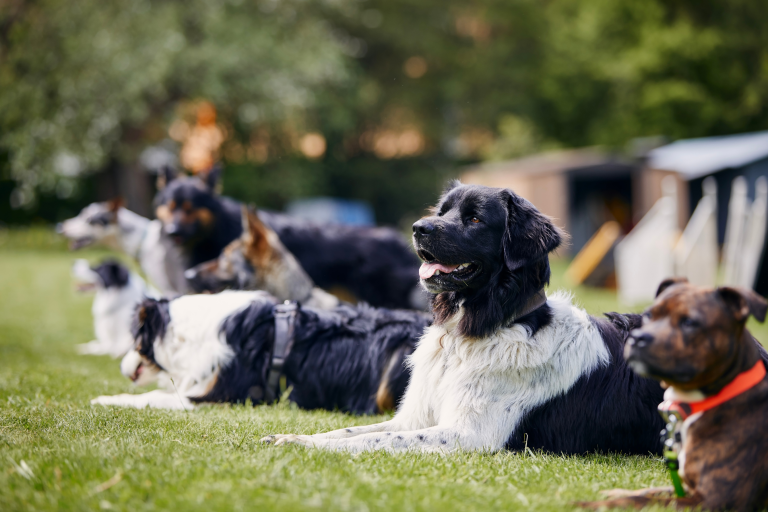More Dogs, More Energy — and More to Manage
Summer is prime time for social gatherings, group hikes, family reunions, and backyard BBQs. If you have more than one dog — or if your dog spends time around other household or visiting dogs — managing that group energy is critical.
Even well-behaved dogs can start to compete, escalate excitement, or ignore known commands when in a pack. But with the right approach, multi-dog environments can stay calm, structured, and enjoyable for everyone.

Leadership Starts With You
Dogs in a group often look to each other for cues — unless they have a clear leader to follow. That leader is you.
Before adding more dogs into the mix, make sure:
- Each individual dog has solid obedience
- You can manage each one on a leash
- You’re reinforcing structure at home and on walks
- You don’t rely on dogs to “work it out” themselves
Your energy, tone, and direction keep the group balanced.
Use Structured Walks to Build Neutrality
Avoid letting dogs pull toward each other with excitement. Instead:
- Walk dogs side-by-side at heel
- Keep leashes short but loose
- Don’t allow socialization during the walk
- Pause periodically to reinforce “sit” or “down”
- Switch up walking order and position to keep them attentive
These walks build calm companionship and reduce competitiveness.
Supervise Playtime With Intention
Summer means more outdoor play — but dogs in groups often ramp up quickly. Be mindful of:
- One dog becoming overly dominant
- Play turning into bullying
- Resource guarding over toys or attention
- Dogs ignoring commands when aroused
Use short play sessions (5–10 minutes), call breaks, and enforce timeouts if things escalate. Teaching dogs to pause during play builds better control.
Use “Place” or “Crate” to Reset Energy
If the pack energy gets too high indoors or outdoors, give everyone a break.
- Crate individual dogs to calm them down
- Use “place” commands to establish calm zones
- Rotate freedom between dogs if needed
- Avoid letting dogs run wild or wrestle indoors
Dogs benefit from structured rest just as much as exercise.
Avoid Feeding Frenzies
Food time can trigger fights or guarding behaviors. When feeding multiple dogs:
- Use crates or separate rooms
- Make each dog wait for a release before eating
- Pick up bowls immediately after meals
- Never feed loose treats in a chaotic setting
Meal structure reinforces calmness and respect.
One-on-One Time Still Matters
Even in a group, each dog needs individual attention. This can be:
- Solo training walks
- One-on-one play
- Quiet affection time
- Focused obedience without distraction
This helps each dog stay balanced and prevents competition for your attention.
Be the Calm in the Chaos
If a group of dogs starts to spiral into barking, chasing, or chaos, stay calm and assertive. Avoid yelling or frantic energy — it only adds fuel.
Instead:
- Step in confidently
- Use leashes to separate if needed
- Send dogs to place or crate
- Resume activity only after calm is restored
Structure doesn’t kill fun — it protects it.
Final Thoughts: A Pack Without Structure Turns to Instinct
Multi-dog homes or gatherings can either bring harmony or headaches. The difference lies in leadership, structure, and consistent expectations.
Train each dog individually, manage group dynamics with awareness, and step in early when energy shifts. With the right structure, summer can be smooth — no matter how many paws are involved.

